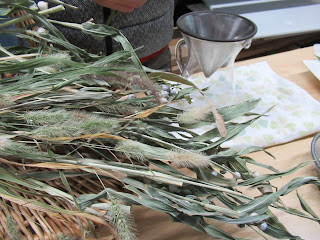OK, let’s continue more exotic kind of forest tisane this week! One thing I noticed during this tea party was, for some leaves microwaving is a useful approach to make their flavor richer. It’s simple: microwaving fresh leaves until they are dry with toasted aroma, but not turning color with burn-marks. Here are the two kids of tisane I thought microwaving did a good job.
6. Harlequin glory bower (Clerodendron trichotonum)
Although above photo is the leaves of turning colors in late autumn, according to Ms. Ohki, we can brew tisane from this tree all year round. In Japanese, the plant is named “Kusagui = a tree smells bad.” So, many participants of the session were surprised to know their leaves can be tisane. I didn’t know either if we could make tisane from it. But I personally find the smell is just like peanuts butter. So, I secretly expected the tisane would have nutty flavor. Bingo! It had a soft nutty aroma, not at all bad.
 |
| Washed
leaves of Harlequin glory bower, before microwaved. |
 |
| In
autumn, fruits of them had a pretty presentation of Harlequin-like demeanor. |
7. Ficus erecta
This tree is commonly found near sea in Kanagawa Prefecture. It is dioecious plant in the genus of fig. The above photo is male hypanthodium sticking to a branch in early winter. Female hypanthodium of Ficus erecta has sweet taste, though not as thick as fig. I once tried male one, and it tasteless … I don’t recommend you try. In any case, like figs, they depend on tiny fly called Blastophaga psenes for pollination. The bags stay deep in the fruit. Especially male flies are born and die in the hypanthodium of male Ficus erecta. i.e. If you bite it, you inevitably enter the world of insect food ... Although I knew such things for Ficus erecta, I was ignorant about its potential of their leaves. Ms. Ohki said tisane from leaves of Ficus erecta often gets the pole position in tasting contest of wild leaves tisane. She microwaved the leaves and tisane had a gentle aroma of forest. In Ms. Ohki’s opinion, when we make a cup from their still-green October leaves, the aroma could be more robust. I’ll try next year!
 |
| Also
another Ficus erecta in July. It’s female and has soon-to-be ripe and sweet hypanthodium. |
 |
| Leaves
of Ficus erecta before microwaved. A slow waving around the rim is their trademark. |
Microwaved leaves can be tisane of woodier flavor than those in fresh leaves. But in terms of late-autumn aroma, another method beats microwave. It’s good ol’ roasting. Here are the two tisanes we tasted with roasted leaves. Both had the mellowest flavor in our tea party session, but with distinctively nutty aroma.
8. Job’s tears (Coix lacryma-jobi)
Last year, I told you my adventure with Job’s tears to make rosary (my post on December 11, 2020). I did not have any idea they can make a good cup of tisane. Come to think of it, the plant is wild ancestor of adlay which is widely consumed as grain and for tisane. No wonder Job’s tears are drinkable. Ms. Ohki did not care if the fruit reached to enamel-like character. She simply chopped the grass of leaves, stems, and fruits, and threw them in a pan (not oiled). Roasting them for few minutes until they emitted nutty aroma, and Voilà! The plant was ready to be infused in a pot. I found their taste is milder than adlay tisane. In Chinese medicine it is said that adlay tea can cool body ... I don’t know if tisane of Job’s tears is good for winter. Though, it’s nutty smell is certainly soothing in autumn afternoon.
 |
| How about catkin tea? |
In that tea tasting session, I’ve learned a lot to enjoy nature just next to us. It’s getting colder now in Yokohama … I’m going to make tea and observe quiet forest this year end … Hibernation ...
657 Nanasawa, Atsugi City, 243-0121
〒243-0121 厚木市七沢657
Phone: 046-248-0323
You can send an enquiry to them by clicking the bottom line of their homepage at http://www.pref.kanagawa.jp/div/1644/








No comments:
Post a Comment